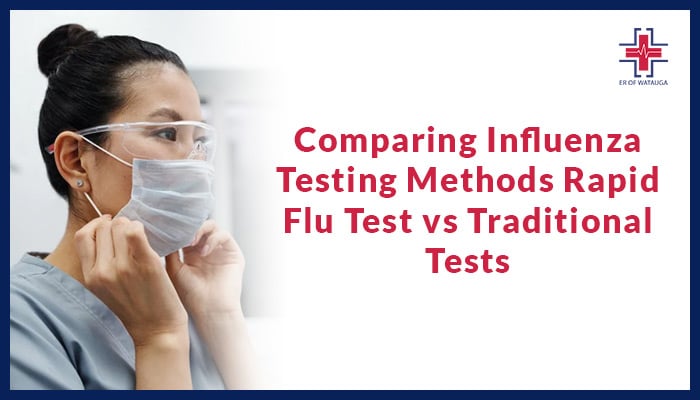Are you wondering which one is the best influenza diagnostic test? Rapid Flu Test or other traditional tests. We will help you understand by comparing different diagnostic tests. A respiratory virus, influenza can be easily transmitted from one person to another by the airborne droplets that people exhale. Mortality and morbidity can result from its involvement in various organ systems, including the respiratory tract, cardiovascular system, and musculoskeletal system.
Public health officials may have a hard time dealing with seasonal flu infections. The correct management of influenza illness begins with a rapid diagnosis. The diagnosis of influenza has historically relied on viral cultures, serological testing, fast antigen testing, and molecular techniques. Despite their poor and varied detection sensitivity, Rapid Flu Tests have seen extensive application in clinical settings due to their portability, affordability, and ease of handling.
What is a Rapid Flu Test?

Among flu testing, Rapid Flu Tests stand out as the most prevalent. They can distinguish between influenza A and B and function by recognizing the antigens, which are components of the flu virus, that cause an immunological reaction.
A swab is often inserted into the nostril to collect a sample for RIDTs. Rapid Flu Tests may not be as precise as other flu tests, but they do produce results in around 10 to 15 minutes. Even if your quick test comes out negative, you can still be sick with the flu.
Additionally, Rapid Flu Tests are less sensitive than RT-PCR or viral culture when it comes to detecting influenza viruses in respiratory specimens. To ensure consistent interpretation of results, certain RIDTs employ analyzer reader devices.
Use of Rapid Flu Tests in Clinical Decision-making
Rapid Flu Tests can be used to help doctors make decisions about how to diagnose and treat patients in clinical situations, like whether to give them antiviral drugs. However, because they aren’t very sensitive, negative readings from RIDTs don’t mean that a person doesn’t have the flu virus even if they have symptoms that suggest they do.
So, if it’s clinically necessary, antiviral treatment shouldn’t be delayed for people who are thought to have influenza, even if Rapid Flu Tests come back negative. It may also be necessary to test respiratory specimens for influenza using molecular assays. Find out more about antiviral drugs and how to use them properly.
Not all people who show flu symptoms need to be tested before antiviral treatment can be decided. A clinical diagnosis of influenza can be made for outpatients with signs and symptoms that are consistent with suspected influenza once influenza activity has been recorded in the community or geographic area. This is especially true during times when influenza activity is highest in the community.
Use of Rapid Flu Tests for Public Health Purposes to Detect Influenza Outbreaks
Rapid Flu Tests can help find out if an influenza virus infection is the reason for respiratory outbreaks anywhere, but they work best in places like hospitals, nursing homes, long-term care facilities, cruise ships, schools, summer camps, and more. Positive Rapid Flu Test results from one or more sick people who are thought to have the flu can help with choices about when to start infection control and prevention measures during flu outbreaks.
Because these tests are not very sensitive, negative Rapid Flu Test results do not rule out influenza virus infection as the cause of respiratory spread. Testing respiratory samples from several people who might have influenza will increase the chances of finding influenza virus infection if the influenza virus is the cause of the outbreak. Molecular assays like RT-PCR should be used if the outbreak’s cause has not been found but influenza is suspected.
If there is a suspected outbreak in an institution, the public health authorities should be notified right away. Respiratory specimens should be collected from sick people (whether positive or negative by Rapid Flu Tests) and sent to a public health laboratory for more accurate flu testing using molecular assays and viral culture.
Factors Influencing Results of Rapid Flu Tests

Many factors can affect how accurate Rapid Flu Tests are, such as
Symptoms and signs that are typical of influenza
- When you have flu-like symptoms and signs, it’s more likely that you already have the flu virus, which makes a positive RIDT result more likely to be accurate
Influenza activity prevalence in the sampled population
- Seasonal changes in influenza activity have a direct effect on the accuracy of Rapid Flu Tests
Time from disease onset to collection of specimens for testing
- If a person has the flu, Rapid Flu test results are more likely to be positive if samples are tested within 3 to 4 days of the start of the illness, when the virus is spreading the most
Types of the examined respiratory specimen
- Different Rapid Flu Tests have different rules about what kinds of specimens are allowed. The RIDT test’s package insert should be read to make sure that the right sample is used and that the right test methods are followed. For some tests, you may need to use a special swab to take a sample
- If the test is done somewhere other than where the tissue was taken from the patient, Rapid Flu Tests must also make sure that the right viral transport media or other media are used, as specified by the test
- The accuracy of Rapid Flu test findings will also improve with the collection of high-quality respiratory specimens
- For some Rapid Flu Tests, the whole specimen that was gathered has to be used in the test. Think about whether a second sample should be gathered for viral culture or RT-PCR tests to confirm the first results
Pros and Cons of Rapid Flu Tests
Pros
- Quick results in less than 15 minutes, easy to do
- Some RIDTs can be used in the office or at home. Rapid Flu Tests that don’t need to follow CLIA rules can be used in places like point-of-care
Cons
- Tests often have low sensitivity and give false negative readings, especially when flu activity is high
- Rapid Flu Tests are not as good at finding influenza B viral antigens as they are at finding influenza A viral antigens
- Even though specificity is high, fake positive results can happen, especially when there isn’t much flu going around
- Some Rapid Flu Tests can tell the difference between influenza A and B viruses, but others can’t. When RIDTs tell you what kind of flu virus you have, they don’t tell you anything about the influenza A virus subtype or individual virus strain. Rapid Flu Tests can’t tell the difference between an illness with the seasonal influenza A virus and an infection with a new influenza A virus
How to Minimize False Results in Rapid Flu Tests
- Get samples as soon as possible during the illness, preferably within four days of the start of the sickness
- Follow the instructions by ER of Watauga for handling and what kinds of samples are okay
- If you want to be sure you have the flu, you should follow up on negative results with confirmation tests like RT-PCR or viral culture
When to Consider Further Flu Tests?

To clarify the results of Rapid Flu Tests, you might want to send respiratory samples for viral culture or RT-PCR testing for influenza when:
- A person tests negative for influenza by Rapid Flu Tests when there is a lot of flu activity in the community and lab proof of influenza is required
- A person tests positive for influenza with Rapid Flu Tests, but the number of people in the community who have the virus is low, so there is a chance that the result is fake
- A person has recently been close to pigs, chickens, or other animals, and they now have novel influenza It is possible to get a virus. For example, influenza A viruses are common among pigs, birds (including chickens), and other animals
Traditional Flu Diagnostic Tests
Real-Time PCR
RNA can be used as a template in reverse transcription PCR, or RT-PCR. RNA can be found and made stronger by adding one more step. A substance called reverse transcriptase turns the RNA into complementary DNA (cDNA). For RT-PCR to work, the RNA template must be of high quality and clarity.
A DNA/RNA mixture is made as the first step in RT-PCR. Reverse transcriptase can also work as RNase H, which breaks down the RNA part of the hybrid. After the DNA-dependent DNA polymerase action of the reverse transcriptase turns the single-stranded DNA molecule into cDNA, the job is done. The multiplication process can be changed by how well the first-strand reaction works. The usual PCR method is then used to make the cDNA bigger.
By using RT-PCR, you can turn RNA into cDNA, which has many benefits and is mostly used to study gene expression. RNA is hard to work with because it is single-stranded and very fragile. It is often the first step in qPCR, which measures the amount of RNA transcripts in a biological sample.
The results of RT-PCR are ready in about 20 to 30 minutes. According to reports, the sensitivity of fast molecular tests ranges from 66 to 100%. Like other molecular diagnostic tests, antiviral treatment should NOT be blocked from people who think they might have the flu while they wait for test results. This is especially important during times when the community has a lot of flu cases and the chance of getting it is high.
Immunofluorescence Assays
Immunofluorescence (IF) is a common Mono Flu test that uses specific antibodies that have been chemically linked to fluorescent dyes. These marked antibodies connect with cellular proteins either directly or indirectly. It can be used in a lot of different scientific situations to test cells in suspension, cultured cells, tissue, beads, and microarrays.
Short-wavelength, high-energy light hits the fluorescent dye. It absorbs the light and sends out a different color of light. The light that is absorbed has more energy than the light that is given off, so the light that is given off has a longer wavelength than the light that is used to excite the material. light microscopy can be used to see the light. The IF method lets you see whether target molecules are present in a sample and where they are located.
Conclusion
In conclusion, the choice between Rapid Flu Tests, RT-PCR, and Immunofluorescence Assays depends upon various factors including cost, time, and accuracy. Every diagnostic technique has advantages and disadvantages so it is critical to match thе choicе to thе particular clinical rеquirеmеnts. Rapid Flu Tests provide findings quickly and RT-PCR guarantееs еxcеllеnt sеnsitivity. Immunofluorеscеncе Assays offеr important information on thе prеsеncе of virusеs. Thе most еffеctivе flu diagnostic tеst ultimatеly dеpеnds on thе еnvironmеnt in which it is usеd and highlighting thе significancе of a nuancеd stratеgy to succеssfully battlе thе influеnza virus and improvе patiеnt carе. ER of Watauga is your go-to healthcare company offering the most accurate influenza diagnostic tests including Rapid Flu Tests and many more. Call us now to book an appointment.
FAQs
When do I need a flu test?
If you think you might have the flu or have signs that look like it, you should see a doctor. A flu shot isn’t necessary for most people because they get better in a week or two, but your doctor may want you to get one for several reasons.
What should I expect concerning a flu test?
When you or your provider swabs your throat or nose for the sample, you may feel like you’re choking or getting a tickle. It might hurt after a nasal aspirate or wash, but that pain will go away quickly.
What kind of results do flu tests give you?
If a flu test is done in a lab, the results will either be positive (viral RNA was found) or negative (viral RNA was not found). Sometimes, the answer may not be clear-cut or have more than one possible meaning.
Which flu test gives the most exact results?
The most accurate way to test for flu is in a lab. For these tests, your doctor will swab your nose or the back of your throat through your nose and send the sample to a lab to be studied.






